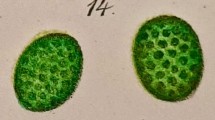Summary
The ultrastructure of isolated generative cells ofAllemanda neriifolia at interphase and prophase was studied. The microtubule organization of the isolated cells was also investigated by immunofluorescence microscopy with a monoclonal anti-α-tubulin. After the generative cells had been isolated from the growing pollen tubes by osmotic shock, most of the cells were at prophase and only a few were at interphase. The interphase cell is spindle shaped and contains an ellipsoidal nucleus. In addition to the usual organelles, the cytoplasm of the interphase cell contains numerous vesicles (each measuring 40–50 nm in diameter) and two sets of longitudinally oriented microtubule bundles — one in the cortical region and the other near the nucleus. Most of the prophase cells are spherical in shape. Based on the ultrastructure and the pattern of microtubule cytoskeleton organization three types of prophase cells can be recognized. (1) Early prophase cell, which contains the usual organelles, numerous vesicles, and a spherical nucleus with condensed chromosomes. Longitudinally oriented microtubule bundles can no longer be seen present in the early prophase cell. A new type of structure resembling a microtubule aggregate appears in the cytoplasm. (2) Mid prophase cell, which has a spherical nucleus containing chromosomes that appear more condensed than those seen in the early prophase cell. In addition to containing the usual organelles, the cytoplasm of this cell contains numerous apparently randomly oriented microtubules. Few vesicles are seen and microtubule aggregates are no longer present. (3) Late prophase cell, typified by the lack of a nuclear envelope. Consequently, the chromosomes become randomly scattered in the cytoplasm. Microtubules are still present and some become closely associated with the chromosomes. The changes in the ultrastructure and in the pattern of microtubule organization in the interphase and prophase cells are discussed in relation to the method of isolation of the generative cells.
Similar content being viewed by others
References
Allen NS, Brown DT (1988) Dynamics of the endoplasmic reticulum in living onion epidermal cells in relation to microtubules, microfilaments, and intracellular particle movement. Cell motil cytoskeleton 10:153–163
Angold RE (1968) The formation of the generative cell in the pollen grain ofEndymion non-scriptus (L). J Cell Sci 3:573–578
Charzynska M, Lewandowska E (1990) Generative cell division and sperm cell association in the pollen grain ofSambucus nigra. Ann Bot 65:685–689
Cresti M, Ciampolini F, Kapil RN (1984) Generative cells of some angiosperms with particular emphasis on their microtubules. J Submicrosc Cytol 16:317–326
Heslop-Harrison J (1968) Synchronous pollen mitosis and the formation of the generative cell in massulate orchids. J Cell Sci 3:457–466
Heslop-Harrison J, Heslop-Harrison Y, Cresti M, Tiezzi A, Moscatelli A (1988) Cytoskeletal elements, cell shaping and movement in the angiosperm pollen tube. J Cell Sci 91:49–60
La Fountain KL, Mascarenhas JP (1972) Isolation of vegetative and generative nuclei from pollen tubes. Exp Cell Res 73:233–236
Miki-Hirosige H, Nakamura S, Takahashi T, Tanaka I (1988) Ultrastructural observations on isolated and cultured protoplasts of lily pollen. In: Cresti M, Gori P, Pacini E (eds) Sexual reproduction in higher plants. Springer, Berlin Heidelberg New York Tokyo, pp 239–244
Nakamura S, Miki-Hirosige H (1985) Fine-structural study on the formation of the generative cell wall and intine-3 layer in a growing pollen grain ofLilium longiflorum. Am J Bot 72:365–375
Quader H, Schnepf E (1986) Endoplasmic reticulum and cytoplasmic streaming: Fluorescence microscopical observations in adaxial epidermis cells of onion bulb scales. Protoplasma 131:250–252
Quader H, Hoffmann A, Schnepf E (1987) Shape and movement of the endoplasmic reticulum in onion bulb epidermis cells: Possible involvement of actin. Eur J Cell Bio 44:17–26
Raudaskoski M, Astrom H, Perttila K, Virtanen I, Louhelainen J (1987) Role of the microtubule cytoskeleton in pollen tubes: an immunocytochemical and ultrastructural approach. Biol Cell 61:177–188
Russell SD, Rougier M, Dumas C (1990) Organization of the early post-fertilization megagametophyte ofPopulus deltoides: Ultrastructure and implications for male cytoplasmic transmission. Protoplasma 155:153–165
Sanger JM, Jackson WT (1971) Fine structure of pollen development inHaemanthus katherinae Baker. II. Microtubules and elongation of the generative cells. J Cell Sci 8:303–315
Tanaka I (1988) Isolation of generative cells and their protoplasts from pollen ofLilium longiflorum. Protoplasma 142:68–73
Tanaka I, Nakamura S, Miki-Hirosige H (1989) Structural features of isolated generative cells and their protoplasts from pollen of some Liliaceous plants. Gamete Res 24:361–374
Tiezzi A, Cresti M, Ciampolini F (1986) Microtubules inNicotiana pollen tubes: ultrastructural, immunofluorescence and biochemical data. In: Cresti M, Dallai R (eds) Biology of reproduction and cell motility in plants and animals. University of Siena, Siena, pp 87–94
Tiezzi A, Moscatelli A, Ciampolini F, Milanesi C, Murgia M, Cresti M (1988) The cytoskeletal apparatus of the generative cell in several angiosperm species. In: Cresti M, Gori P, Pacini E (eds) Sexual reproduction in higher plants. Springer, Berlin Heidelberg New York Tokyo, pp 215–220
Van Lammeren AAM, Keizzer CJ, Williemse MTM, Kieft H (1985) Structure and function of the microtubular cytoskeleton during pollen development inGasteria verrucosa (Mill.) H. Daval. Planta 165:1–11
Xu SX (Zee SY) (1991) Division in isolated generative cells ofAllemenda neriifolia. Acta Bot Sin (in press)
Zee SY, Aziz-Un-Nisa (1991) Mitosis and microtubule organizational changes in isolated generative cells ofAllemanda neriifolia. Sex Plant Reprod 4:132–137
Zhou C (1988) Isolation and purification of generative cells from fresh pollen ofVicia faba L. Plant Cell Rep 7:107–110
Zhou C, Wu XL (1990) Mass isolation and purification of generative cells from pollen grains. Acta Bot Sin 32:404–406
Zhou C, Orndorff K, Allen RD, DeMaggio AE (1986) Direct observations on generative cells isolated from pollen grains ofHaemanthus katherinae Baker. Plant Cell Rep 5:306–309
Zhou C, Orndorff K, Daghlian CP, DeMaggio AE (1988) Isolated generative cells in some angiosperms: a further study. Sex Plant Reprod 1:97–102
Zhou C, Zee SY, Yang HY (1990) Microtubule organization of in situ and isolated generative cells inZephyranthes grandiflora Lindl. Sex Plant Reprod 3:213–218
Author information
Authors and Affiliations
Rights and permissions
About this article
Cite this article
Zee, S.Y. Ultrastructure and microtubule organization of isolated generative cells ofAllemanda neriifolia at interphase and prophase. Sexual Plant Reprod 5, 27–33 (1992). https://doi.org/10.1007/BF00714555
Issue Date:
DOI: https://doi.org/10.1007/BF00714555




